引子
Introduction
我们都知道金属制品在海洋中容易产生腐蚀,一方面是因为海水具有腐蚀性,另一方面海洋微生物、附着生物及它们的代谢产物等都对腐蚀过程产生直接或间接的加速作用。那么海洋腐蚀的种类究竟有几种呢?
We all know that metal products in the ocean are prone to corrosion because of the corrosive nature of seawater and the direct or indirect accelerating effects of marine microorganisms and attached organisms as well as their metabolites on the corrosion process. So what types does marine corrosion contain?

海洋腐蚀
Marine Corrosion
构件在海洋环境中发生腐蚀,腐蚀类型主要有均匀腐蚀、点蚀、缝隙腐蚀、湍流腐蚀、空泡腐蚀、电偶腐蚀和腐蚀疲劳等,这些腐蚀现象的发生往往与金属构件的结构和工艺相关。
Corrosion of components in the marine environment mainly includes uniform corrosion, pitting corrosion, crevice corrosion, turbulence corrosion, cavitation corrosion, galvanic corrosion and corrosion fatigue, etc., which is often related to the structure and process of metal components.
均匀腐蚀
Uniform Corrosion
均匀腐蚀是指在金属表面上几乎以相同的速度所进行的腐蚀,与在金属表面上产生的任意形态的全面腐蚀不同。均匀腐蚀一般发生在阴极区和阳极区难以区分的地方。
Uniform corrosion refers to that taking place on the metal surface at almost the same rate, different from the full-scale corrosion on the metal surface in any form. Uniform corrosion generally occurs in the area where cathodic area and anodic area are difficult to be distinguished.
点蚀
Pitting Corrosion
金属表面局部区域出现向深处发展的腐蚀称为点蚀,而金属的其余区域则无明显腐蚀发生。点蚀具有“深挖”特性,即蚀孔一旦形成,往往自动向深处腐蚀,因此具有极大的破坏力和隐患性。点蚀不仅与环境中分散的盐粒或污染物相关,同时也与材料本身的表面状态和处理工艺相关。
The phenomenon that corrosion takes place in local areas and other areas are free of corrosion is called pitting corrosion. Pitting corrosion has a characteristic of “deep digging”, that is, once the corrosion holes are formed, they often automatically develop to the depth, and therefore having a great destructive power and hidden danger. Pitting corrosion is not only related to the dispersed salt particles or contaminants in the environment, but also to the surface condition of the materials and the treatment process.
缝隙腐蚀
Crevice Corrosion
部件在介质中,由于金属与金属(或非金属)之间形成特别小的缝隙,使缝隙内的介质处于滞流状态而引起缝内金属的加速腐蚀,这种局部腐蚀称为缝隙腐蚀。该腐蚀在海洋飞溅区和海水全浸区最为严重,同时在海洋大气中也有发现。几乎所有金属和合金都会发生缝隙腐蚀。
Because there is a small gap between the metals (or non-metals), the medium in the gap is in the stagnant state and then accelerated corrosion of the metal in the gap occurs. The local corrosion mentioned above is called crevice corrosion. This kind of corrosion is most obvious in the marine splash zones and seawater full immersion zones, and it can also be seen in the marine atmosphere. Almost all metals and alloys will suffer from crevice corrosion.
湍流腐蚀
Turbulence Corrosion
在构件的某些特定部位,由介质流速急剧增大形成的湍流引起的磨蚀称为湍流腐蚀。许多金属如钢、铜、铸铁等对速度非常敏感,当速度高于某一临界值时会发生快速侵蚀。湍流腐蚀常常伴随有空泡腐蚀,有时两者甚至很难区分。冲击腐蚀也属于湍流腐蚀的范畴,是指高速流体的机械破坏和电化学腐蚀这两种作用对金属共同破坏的结果。
In some specific parts of the component, the erosion caused by the turbulence coming from the rapid increase of the flow rate of the medium is called turbulence corrosion. Many metals such as steel, copper and cast iron are very sensitive to current speed, and when the speed is higher than a certain critical value, rapid erosion will occur. Turbulence corrosion is often accompanied by cavitation corrosion, and sometimes it is even difficult to distinguish between the two. Impingement corrosion also belongs to the turbulence corrosion, and it refers to the damage caused by high-speed fluid and electrochemical corrosion.
空泡腐蚀
Cavitation Corrosion
流体与金属构件做高速相对运动时。在金属表面局部地区产生涡流,伴随有气泡在金属表面迅速生成和破灭,呈现与点蚀类似的破坏特征,这种条件下产生的磨蚀称为空泡腐蚀,又称空穴腐蚀或汽蚀。该类腐蚀多呈蜂窝状,是电化学腐蚀与气泡破灭产生的机械损伤共同作用的结果。
When the fluid and metal components do high-speed relative motion, vortex in the local area of the metal surface occurs, accompanied by the quick generation and breakage of bubbles. It is similar to the pitting corrosion, and this phenomenon produced in such a condition is called cavitation corrosion, also known as vapor corrosion. This type of corrosion is mostly represented by the shape of honeycomb, which is the result of the mechanical damage of electrochemical corrosion and bubble breakage.
电偶腐蚀
Galvanic Corrosion
电偶腐蚀是由于一种金属与另一种金属或电子导体构成的腐蚀电池的作用而造成的腐蚀。当两种不同的金属相连接并暴露在海洋环境中时,通常会产生严重的电偶腐蚀。电偶腐蚀的严重程度主要取决于两种金属在海水中电位序的相对差别和相对面积,但是也与金属的极化性相关。通常可采用在两金属连接处加绝缘层或是在电偶阴极上覆以绝缘保护涂层的方法来控制或抑制电偶腐蚀。
Galvanic corrosion is caused by the corrosion cells which are the results of the interaction between metals and metals or metals and electronic conductors. When two different metals are joined and exposed to the marine environment, severe galvanic corrosion usually occurs. The severity of galvanic corrosion depends primarily on the relative difference and relative area of galvanic series of the two metals in seawater, and it is also related to the polarizability of the metals. Galvanic corrosion can usually be controlled or inhibited by adding an insulating layer to the connection between the two metals or by coating the galvanic cathode with an insulating protective layer.
投稿者:张炜峰 硕士研究生
审核导师:沈义俊 教授
 公众号
公众号